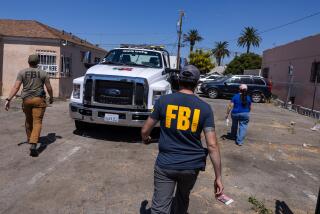No Rules When Trafficking in People
As the lucrative trade in women has grown throughout the world, police have tried to trace the changing routes of traffickers--sometimes the same underground pathways used by drug dealers, sometimes the air-conditioned departure lounges of international airports.
“There don’t seem to be any hard and fast patterns. Traffickers use any number of ruses to get people where they want them to go,” said Martina Vandenberg, a Washington, D. C.-based researcher for Human Rights Watch, an international advocacy group.
Thomas Fuentes, chief of the FBI’s organized crime section, said, “They move their cargo the fastest, least expensive way they can. They don’t follow any rules.”
But on occasion, investigators crack a sex trafficking network and glimpse the workings of sex smuggling.
The sight is not pretty, as illustrated in the recent case of a Thai boy known as Got. Got was 2 years old, malnourished, HIV-positive and suffering from a severe ear infection when he arrived at Los Angeles International Airport in April 2000, accompanied by a couple who claimed to be his parents.
Officials determined that he was being used in a scheme to smuggle the woman into the country. His own mother had rented him out to the smugglers.
In July, Atty. Gen. John Ashcroft made the boy the first candidate for the so-called T-visa, allowing him to stay in the United States for three years and eventually adjust to resident status.
“That case opened a lot of eyes,” Vandenberg said. “The way they used that boy illustrated how ruthless the traffickers can be.”
Mike McMahon, director of the Houston office of the U. S. Immigration and Naturalization Service, said one successful investigation showed that traffickers of both people and drugs were forming alliances.
“We learned that they move the people from the East to Central America and up into Mexico using established drug routes there and into the U. S.,” McMahon said. “There has been cooperation between the Thai smugglers and Mexican smugglers.”
When the FBI investigated why five Latvian women in their 20s all received U. S. tourist visas and listed the same suburban Chicago apartment as their temporary home, agents first suspected an organized-crime trafficking network. Instead, the operation revolved around small-time hustlers.
One man stood on street corners in Riga, Latvia, telling pretty young women that they could make $30,000 and see the world. His buddy, a cabby living outside Chicago, would taxi the women to dancing engagements. A copy of the movie “Striptease” served as an instructional aid.
“It doesn’t have to be real complicated,” Fuentes said.
One consistency is found in the routes: They run from poor to richer countries.
For example, officials say traffickers deliver women to Portugal--and onward through Europe’s open borders--from Portuguese-speaking Brazil and former Portuguese colonies such as Mozambique, Angola and Macao.
“Portugal is the stepping stone,” said Ines Fontinha, who heads the O Ninho prostitute shelter in Lisbon.
“It is a question of supply and demand,” said Tej Bunnag, Thailand’s U. S. ambassador. “So long as there is a demand for anything, from nuclear scientists to doctors to computer programmers down to prostitutes, then you are going to get them.”
More to Read
Sign up for Essential California
The most important California stories and recommendations in your inbox every morning.
You may occasionally receive promotional content from the Los Angeles Times.










